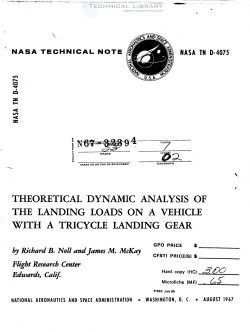NASA-TN-D-4075
- Version
- 133 Downloads
- 3.04 MB File Size
- 1 File Count
- May 10, 2017 Create Date
- May 10, 2017 Last Updated
Theoretical Dynamic Analysis of the Landing Loads on a Vehicle with a Tricycle Landing Gear

A theoretical analysis is presented for the landing dynamics of a vehicle equipped
with a tricycle landing—gear system. The equations are simplified in order to provide
a more convenient yet adequate analysis for most vehicles. The adequacy of the sim—
plified analysis for simulating the landing dynamics and loads of a vehicle is illustrated
by comparing results of calculations with flight—test data from the X-15 research air—
plane. The feasibility of using the modified analysis for investigating off-design landing
contingencies is demonstrated by examples of studies performed for the X-15.
The dynamics of a conventional tricycle landing—gear system are generally well
understood. However, unusual dynamic problems may arise if the basic gear system
is modified for use on special types of vehicles where considerations such as simplic—
ity, ease of stowage, resistance to thermal loads, or directional stability on the
ground are major design factors. The X—15 research airplane is a prime example of
a vehicle with unique landing dynamic problems caused by a modified tricycle gear
system (refs. 1 to 4). Although a dynamic analysis had been used in the design of the
X—15 gear, it was apparent from flight-test results that the landing dynamics of the
complete vehicle system had not been satisfactorily simulated (ref. 4). In order to
study the landing dynamics and parameters affecting the landing loads of unusual con—
figurations, the six rigid—body degrees of freedom plus a degree of freedom for each
gear were programed for analysis on an analog computer.
A simplified form of the analysis, which is described briefly in reference 2, has
proved to be successfiil in uncovering problems of the X—15 landing dynamics (refs. 2
and 3), in predicting landing loads and simulating actual landings (refs. 2 and 3), and
in determining the effects of design changes on landing loads (ref. 4). This paper
presents the extensive analysis as well as the simplified X-15 landing-dynamics
equations in detail and assesses the validity of the simplifications by comparing them
with flight—test results. Analytical predictions of the effects of wing flaps, horizontal-
tail loads, and weight on the X—15 landing loads are discussed briefly.
| File | Action |
|---|---|
| NASA-TN-D-4075 Theoretical Dynamic Analysis of the Landing Loads on a Vehicle with a Tricycle Landing Gear.pdf | Download |
Comment On This Post